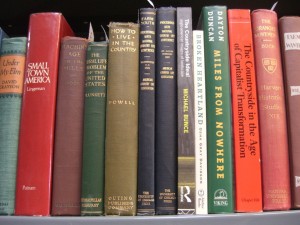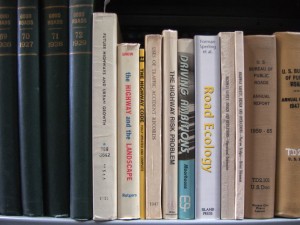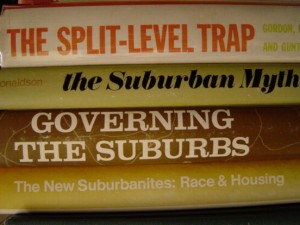The Library’s Organizational System
The library is primarily a collection of 19th and 20th century historical ephemera, periodicals, maps, and books, most published in the United States. Much of the collection is image-rich, and in the public domain. The library specializes in material that is not commonly found in other public libraries.
The library has three major sections: The main shelves, the ephemera collection, and, in Row Six, holdings of standalone collections and oversize materials.
Main Shelves
The main shelves are organized according to the library’s unique geospatial taxonomy. This arrangement system classifies subjects spatially and conceptually beginning with the physical world, moving into representation and culture, and ending with abstractions of society and theory. It can be summarized as a walk through a landscape of ideas, from feet-on-the-ground to outer space. Within that framework are dozens of associative links between subject sections, moving from site-specific, to mediated, to abstract; from particular to general, and from micro- to macro-. The geospatial system is set up in five rows, each row holding part of the structure in a consistent series of smaller sections. The system begins at the front of Row One and ends at the back of Row Five.
Details below.
Each labeled section on the main shelves is a composed set of juxtapositions, bringing together government documents, periodicals, monographs, and occasional works of fiction, in greater or lesser order, to illuminate a subject area. Within these sets, the compositional structure is fairly loose. The periodicals listed here are central elements of the subject sections.
Ephemera Collection
At the back of the room a pair of facing shelves holds over 700 gray archival boxes. These are the library’s loose and fragile materials: pamphlets, clippings, single issues of periodicals, flyers, photographs, etc. These holdings are organized at the box level, and their arrangement replicates the main shelves’ geospatial arrangement system. This part of the collection is not self-service.
Standalone and Oversize Collections
The library contains a number of standalone collections. From artists’ books to children’s literature to zine libraries to reference materials, these collections are shelved in Row Six, independent of the geospatial system. Also in Row Six are holdings of oversize books and ephemera, and these are arranged on the shelf in a pattern echoing the geospatial system (labeled as “Row One subjects…” etc.).
Detailed Description of the Main Shelves
The lists of identified “specialties” are designed to draw attention to unusual subject areas, and to point to subject areas where the library’s holdings are of major research significance.
Row One
 |
Row One opens with the California bank, arranged top-to-bottom, north-to-south, with three shelves of books on San Francisco at eye level. The next bank assembles the non-California Pacific Coast regions from Alaska to Hawai’i, including beachcombing the Pacific. The first half of the row follows as a rough U.S. map, with Northern Plains at the top and finally an entire bank on New York. Specific places then yield to general subjects of the physical environment: global geography and cartography, then the natural history section, which includes unusual illustrated materials. Nature/culture interface, agriculture, rural life, landscape studies, and extractive resource industries lead to the end of Row One. |
Row One specialties include:
- California and Bay Area history and culture
- Oregon history
- Midwest U.S. history and culture, including Detroit
- New York City history
- Lydekker Library of Natural History, vols. 1-6
- environmental paperbacks from 1970 and 1971
- U.S. Department of Agriculture yearbooks and bulletins
- monograph collection on landscape studies, cultural geography, and rural America
- forestry journals
- the Fish Skulls book
- Shell Progress (Shell Oil Co.) and The Lamp (Standard Oil of New Jersey)
|
Row Two
  |
Row Two opens with trade journals on industrial and manufacturing processes, then holds a home crafts and how-to section (a section originally developed for Maker Faire in 2008 and 2009), followed by safety and transportation. The home crafts section is a cul-de-sac: Row Two’s sequence of associations between subjects flows from extractive resources (in Row One) to manufacturing, to the automotive industry in particular, leading to transportation infrastructure and other modes of transportation: roads, motor homes, buses, bicycles, railways, ships, and aviation. Row Two’s second half continues with other infrastructural networks of the physical environment: electrical and other power systems, and sewers, leading to a regional planning section. The Urban Studies section is one of the largest undivided areas on the main shelves: Spanning three full banks, the volumes in this section are arranged alphabetically by author. Following Urban Studies are subjects of the open spaces within them: parks, gardens, and cemeteries. Lastly, there is a small section on national parks and national public works. |
Row Two specialties include:
- Industrial Management
- National Safety News
- histories of the U.S. road and highway systems
- Aerial Age from the World War I era
- Nucleonics, trade journal of the civil nuclear power industry
- publications of the New Deal-Era National Resources Committee, National Resources Planning Board, and the Resettlement Administration
- a small Civilian Conservation Corps collection
|
Row Three
 |
Row Three continues from Row Two, yet also starts over where many journeys begin, at home. Housing, suburbia, homebuilding, home design, real estate, and architecture round out the library’s taxonomic journey through the physical environment in the first half of Row Three. At the mid-point, architecture segues to art: this is the shift to representation. The art section spans the entire second half this bank, and is organized into over a dozen thematic subjects progressing generally from photography and evidence, to art-making and composition, to new and emerging forms, to graphic design and information design, to commercial art and propaganda. Row Three concludes with Display World, the trade journal of department store window design. |
Row Three specialties include:
- critical histories of suburbia
- homebuilding how-to
- the George Griffin collection of how-to art and photography books
- animation and illustration
- art and politics
- graphic design
- typography
- information design
- graphic design history
- advertising history, including runs of Advertising and Selling, Printers’ Ink, Sponsor, and Tide
- Modern Packaging (with tipped-in packaging samples)
|
Row Four
 |
In Row Four the window becomes the screen, and the screen transmits, then transitions to, cultural phenomena. The history of television collection that fills its first bank dates back to the era when television was seen as a possible means of two-way communication. The next banks cover the history of broadcast and networked telecommunication systems in considerable depth, echoing the infrastructure motif of Row Two: ephemeral film, broadcasting, radio, telephone systems and telegraphy form the center of Row Four. Where subjects of networked systems terminate in computers, Row Four positions computers as transmitters of culture and from there makes a major shift to the cultural sphere: to music. Following music, the American cultural history collection has sections that are arranged both chronologically and thematically, and encompass Black history and Native American history as major anchors before ending in folklore, language, and humor — with jollity, with First Names of Americans and Re/Search: Pranks! |
Row Four specialties include:
- early history of television (1924-1950)
- TV Guide (1953-2009, not fully processed), plus TV Forecast (1948-1953)
- histories of educational and industrial film, and home movies
- history of radio and telephony
- 2600: The Hacker Quarterly
- Quick Frozen Foods journal
- true crime, fringe subcultures
- discourses of race in America
- Black history, including The Black Scholar, Negro Digest, and Black World
- Native American history, including original 19th century documents from the U.S. Department of the Interior detailing domestic anti-Native American policies and strategies
|
Row Five
 |
Row Five starts with Gyn/Ecology and Today’s Secretary, and concludes with Space Colonies and Missiles and Rockets. It is loosely referred to as the “society, theory, and science” row. From gender to outer space, Row Five holds evidence of forces that structure everyday life and processes that unfold at a societal level. Within that, it holds sections on the family, the state, immigration, general American history, right and left dissent movements, geopolitics, and general collections on the major wars of the 20th century. It holds Utopianism and the Whole Earth Review as well as labor history, business history, and economics. Mathematics, science, and space round out the row, expressing the furthest, most abstract, (limitless) “end” of the geospatial taxonomy. |
Row Five specialties include:
- history of prejudice against youth
- U.S. immigration policy
- the historic textbook collection (300 volumes)
- the Branch Davidian conflict
- the Vietnam War
- the atomic era
- Modern Age books (1930s progressive publishing house)
- Co-Evolution Quarterly and Whole Earth Review
- labor history
- intellectual “property”
- history of the U.S. space program
|
Row Six
 |
Row Six has taller, deeper shelves than the other rows. Built to house oversize materials, Row Six only partly engages the library’s taxonomic system. It holds the standalone collections and reference materials in addition to its oversize sections. Row Six oversize sections:
- oversize books: these are arranged by “Row” cluster
- oversize ephemera, also loosely arranged by “Row” cluster
- oversize periodicals, effectively a standalone collection
Row Six standalone collections:
- artists’ books
- folding maps and travel brochures (approximately 180 boxes, arranged geographically)
- science fiction
- children’s literature
- reference
- zine collections (not fully processed, approximately 10,000 items)
- hunting dog periodicals
|
Row Six specialties include:
- artists’ books
- Civilian Conservation Corps camp newsletters (4 boxes)
- political buttons collection
- Whole Earth Catalog series
- oversize city plans from throughout the U.S.
- Mount St. Helens eruption ephemera
- Fortune magazine, Life magazine (complete)
- Living for Young Homemakers
- 19th century children’s magazines (assorted)
- Epicenter Zone zine library
- Punk Planet zine library
- World Almanac (1929-1995)
- Full Cry magazine
|
For a complete list of subject headings, click [here] / [Back to Top]







